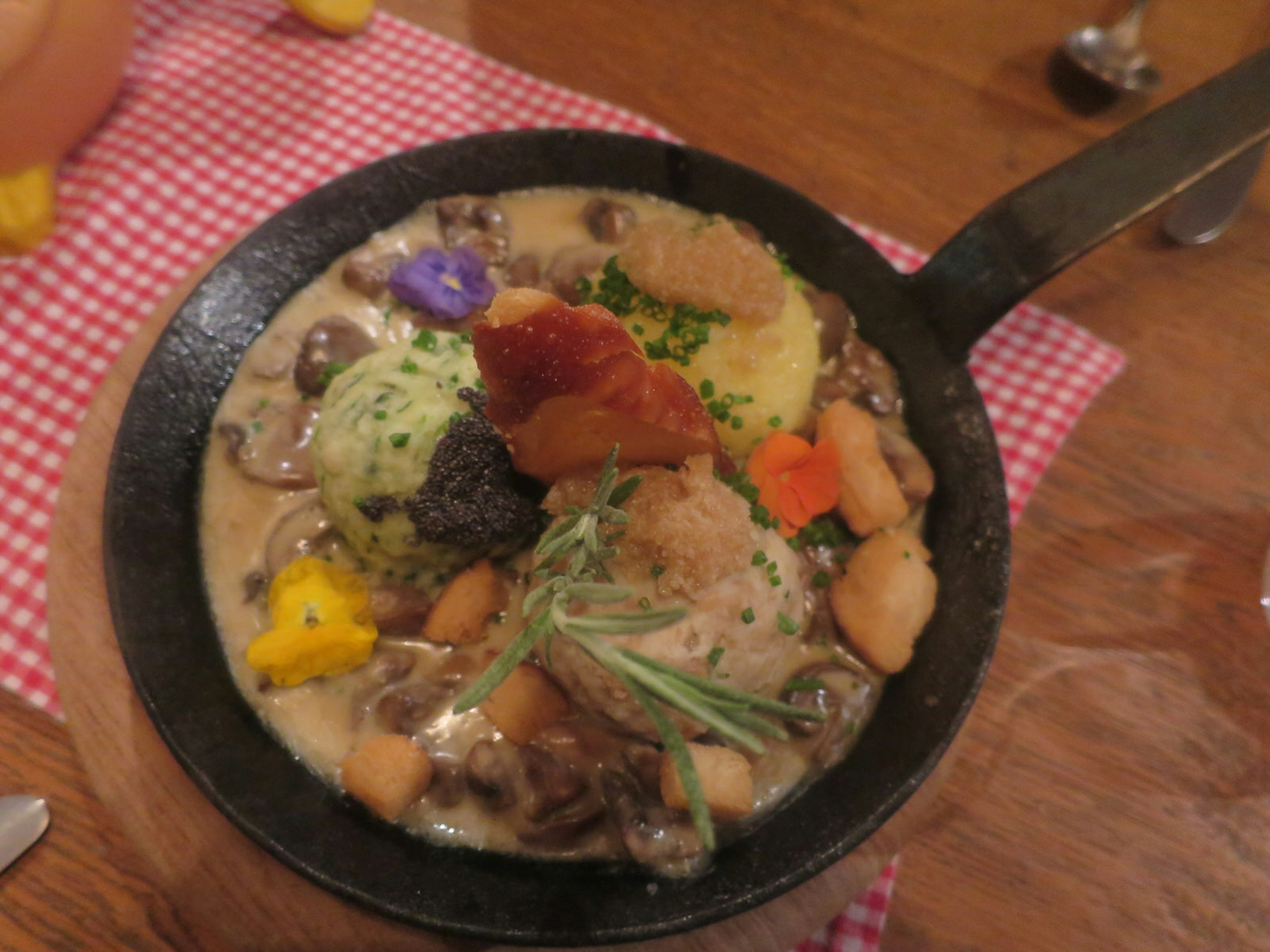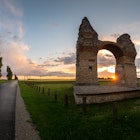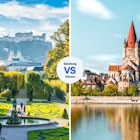
Bavaria & Eastern Germany: why a food and wine tour is not the wurst idea
Jan 25, 2019 • 8 min read

A traditional dish of dumplings, both potato and bread versions, at Ehrbar Weinstube, Frickenhausen © Karyn Noble/Lonely Planet
German wine: Riesling? German food: bratwurst? Better put those generalisations away, you need to get out more; specifically to the under-explored medieval splendour of Frickenhausen in Franconia, to the verdant vineyards of Sulzfeld and Iphofen, to romantic Würzburg with its historical bridge dedicated to convivial wine drinkers, and to Naumburg and Freyburg in the Saale-Unstrut region for bubbles, blissful brunches and boating.
If you’re not feeling the gemütlichkeit (essentially the German version of hygge) after all this sensory indulgence in an adorable Grimms’ fairy-tale setting, you’d better check your pulse.
- placement: fullWidth
- path: articles/in-content-top
- possible size: [970, 250], [970, 90], [728, 90], [300, 250], [320, 50], [1, 1],
- targeting:
{ "url": "bavaria-eastern-germany-food-wine-tour-not-wurst-idea" }

Figure out Franconia
Many visitors to Germany gush over Bavaria, without realising that the northwestern part of the state contains Franconia and that Franconians are pretty unhappy about being considered Bavarians (even though between 1803 and 1806 Franconia was given to the Kingdom of Bavaria). So you’ll notice some subtle differences when you enter Franconia, such as the predominance of a red-and-white flag rather than the Bavarian blue-and-white one. Another big clue is a wine bottle you may recognise as similar in style to that of Portuguese Mateus rosé; in Franconia it’s called a Bocksbeutel and is a symbol of excellence. Only Franconian wines meeting minimum quality standards (as determined by an independent tasting panel) can be sold in a Bocksbeutel. So, it’s a reassuring sight here, the bottle design dating back to the 16th century. And the grape you need to know about isn’t Riesling, which dominates most of Germany: in Franconia, it’s Silvaner. You’ll find no shortage of it in this wine region; its delicate dry, minerality is a perfect expression of Franconia’s shell limestone terroir. But there are 60 other different wine varietals here too, so find yourself a driver and bring your appetite.

Frickenhausen: too fricken cute
Try to imagine that Hansel and Gretel grew up and invented a tiny village renowned for its wine festivals and quaint charm and you’re getting close to picturing Frickenhausen. There are no tour groups here – big buses won’t even fit under some of the medieval archways and bridges. You’ll just hear church bells (er, all night if you’re on the wrong side of your accommodation; do ask about that/bring noise-cancelling ear plugs) and smell the enticing aroma of slow-cooked pork and dumplings wafting amid the turreted rooftops.
What to eat: Fish from the nearby Main River, prepared with local ingredients at rustic, timber-framed Ehrbar Weinstube pairs well with Silvaner. But start with the Franconian taster plate to get your comfort-food culinary bearings (yes, you’ll see Franconian pork bratwurst wrapped in a croissant; the Grupfter spread comprising Camembert, butter, fresh cream, cumin and paprika; and balls of goose fat and fried onion!). This is also one of the best places to try potato or bread dumplings.
What to drink: A 2017 Meintzinger Silvaner Trocken from Weingut & Hotel Meintzinger, an atmospheric winery in a former monastery (dating from 1475) turned upmarket hotel, just steps from the restaurant. This is a light, dry white with aromas of melon, nuances of apples, pears and a little elderberry. It’s refreshing on the palate and an unobtrusive match for fish.

Sulzfeld and Iphofen: wine tours with a difference
The enchanted theme weaves its way right through Franconia, extending into the intricate designs of its wineries. Take Weingut Brennfleck in Sulzfeld, for example: baroque on the outside, medieval manor house on the inside, it is a stylish, family-owned winery that won an architectural award for incorporating modernity into an old building. Its vineyard dates from 1591, but arriving into the winery’s private courtyard with its landscaped gardens, outdoor furniture and sculptures adorned with rose trellises feels a bit like being at a designer photo shoot. Then, when on a tour of the candlelit cellar, it seems more like a setting for a New Romantic music clip. Don’t let all the artfully placed accessories and hand-carved Franconian oak barrels distract you from the main game, though: Brennfleck is renowned for its white wines, with Silvaner a speciality, and with 30 hectares of vines distributed across different soils here, there’s a distinct focus on quality over quantity.
- placement: fullWidth
- path: articles/in-content-middle
- possible size: [970, 250], [970, 90], [728, 90], [300, 250], [320, 50], [1, 1],
- targeting:
{ "url": "bavaria-eastern-germany-food-wine-tour-not-wurst-idea" }

In Iphofen, you feel like you travel back in time, entering the little village via an arch beneath a turret, where everything is encircled by a remarkably preserved medieval wall. Wander the cobblestone streets, marvel at the gabled houses with pastel shutters, the quaint towers seemingly from storybooks, then remind yourself why you’re in this reverie: can this Disney fantasia somehow be a wine-lovers paradise too? Head for Vinotek Iphofen, a protected four-storey, heritage building, which was a stables in the 1870s, but now showcases products from 20 of the region’s winemakers in adorable half-timbered rooms.
What to eat: Crispy, slow-cooked pork shoulder in dark beer sauce is typical to the region. Try it smothered with crackling and served with potato dumplings and coleslaw on the sunny terrace of 99er Kulinarium in Iphofen, which specialises in local and organic produce.
What to drink: White or red? White-lovers could try the Anna-Lena Silvaner 2017 from Sulzfeld’s Weingut Brennfleck. Named after the oldest daughter of the winemaker, this is a dry wine with a fruity, fresh aroma and a typical Silvaner minerality that straddles both acidity and sweetness, ideal for light meats. Alternatively, try a Domina, made from a popular red grape in Franconia: a cross of Portugieser and Pinot Noir. The 2012er Iphöfer Kronsberg Domina from Weingut Dorsch is ruby red, with aromas of cherries, figs and plums.
Würzburg: capital drinking on Germany’s oldest stone bridge
Franconia’s capital city of Würzburg holds a lot of appeal for wine travellers. Over 80% of the wine produced here is consumed right in the town, mostly on the pedestrianised Alte Mainbrücke (old bridge). Dating from 1543, it arches across the gushing River Main, holding up 12 statues of saints (added around 1730) and lampposts effusive with colourful floral displays. This gives an immediate ‘what’s this party?’ welcoming effect, as locals and visitors alike mill about with glasses of wine purchased from little hole-in-the-wall bars at either end of the bridge.

If you can drag yourself away from the bonhomie, there are more wonderful views to be had, such as from Festung Marienberg, a baroque fortress overlooking all of Würzburg. But also devote time to the magnificent Würzburg Residenz, a palatial structure not unlike Versailles – indeed, it was influenced by it, along with German and Austrian baroque styles, and declared a World Heritage Site in 1981. Admire the intricate Italian frescoes (including the world’s largest) and grand staircases inside and if you’re still thinking about drinks back on the bridge, despair not, the palace has a rather atmospheric winery in the cellar that’s open for tastings: Staatlicher Hofkeller, dating back to 1128. The Residenz’s Court Gardens are sublime when sober, so you may swoon a little when stepping back into daylight after a glass or two.
What to eat: A Michelin-starred restaurant in a Würzburg winery? That’s Reisers am Stein, which also holds cooking classes. It’s a suitably scenic place to unwind after hiking the nearby Stein-Wein-Pfad, a 4km stone path through Würzburg’s vineyards. Try the local stained saibling (char fish) with Franconian antipasti, pumperknickel, apple chutney and horseradish.
- placement: native
- path: articles/in-content-native
- possible size: [f, l],
- targeting:
{ "url": "bavaria-eastern-germany-food-wine-tour-not-wurst-idea" }

What to drink: It’ll definitely be something from Weingut am Stein, the organic biodynamic winery in which Reisers is located. Try their sparkling 2014er Silvana Brut, crafted from Silvaner and Pinot grapes.
Naumburg and Freyburg: the fairy-tale finish with a sail on the Saale
The fairy-tale fun doesn’t stop once leaving Bavaria for more eastern parts of Germany. At Freyburg, in the Saale-Unstrut Region (the most northerly quality wine-growing region of Europe), you’ll find yourself drinking ‘Little Red Riding Hood’. That’s the translation of Rotkäppchen, Germany’s biggest sparkling wine producer, which also owns the German branch of Mumm. Visit Rotkäppchen Sektellerei, for a guided tour of the astounding five-storey cellar with its rock-stadium grandeur and the largest cuvée barrel in the world (created in 1896 from the wood of 25 oaks and decorated in elaborate carvings). When exploring the vineyards of Saale-Unstrut, it’s helpful to conduct some research on Winzervereinigung Freyburg-Unstrut, a cooperative of 400 vintners, who are informative ambassadors for the wine region.

Looking to pace yourself in between all the tastings? Naumburg Cathedral will please culture lovers with its Gothic splendour, otherwise get boating on the Saale River. Your reward at the end could be a huge slab of apfelstrudel on the sunny, vine-covered terrace of Saalhäuser Weinstuben, which is part of Landesweingut Kloster Pforta, a beautiful winery where Cistercian monks used to grow grapes as early as 1137, not to mention the place for passing cyclists to brunch, since it sits directly along the Saale Cycle Route.
What to eat: Seek out Zwiebelkuchen, a savoury German onion cake with diced bacon, cream and caraway seeds that’s available in early autumn only. It’s traditional for South-Central German family winemakers to serve it with new wine (look for a straw broom over a barn/garage doorway: a sign they are ‘serving’). Otherwise, you’ll eat well at Gasthof Zufriedenheit (meaning, Restaurant Satisfaction) in Naumburg: don’t miss the chestnut mousse with valrhona chocolate & two kinds of pear.
What to drink: With your pear dessert, try the 2015 white burgundy Beerenauslese from Freyburger Edelacker, Winery Pawis with fruity, honey notes: a sweet finish to your trip.
Karyn travelled to Germany with help from the German National Tourist Board. Lonely Planet contributors do not accept freebies in exchange for positive coverage.
https://shop.lonelyplanet.com/products/munich-bavaria-black-forest-travel-guide-5
- placement: fullWidth
- path: articles/bottom
- possible size: [970, 250], [970, 90], [728, 90], [300, 250], [320, 50], [1, 1],
- targeting:
{ "url": "bavaria-eastern-germany-food-wine-tour-not-wurst-idea" }
Explore related stories





 Hiking10 of the best day trips from Munich: nature, culture, and fairy-tale castles
Hiking10 of the best day trips from Munich: nature, culture, and fairy-tale castlesMay 18, 2024 • 10 min read
 Festivals & EventsOktoberfest 2024 is approaching: a first-timers' guide to all merry mayhem
Festivals & EventsOktoberfest 2024 is approaching: a first-timers' guide to all merry mayhemMay 8, 2024 • 6 min read



